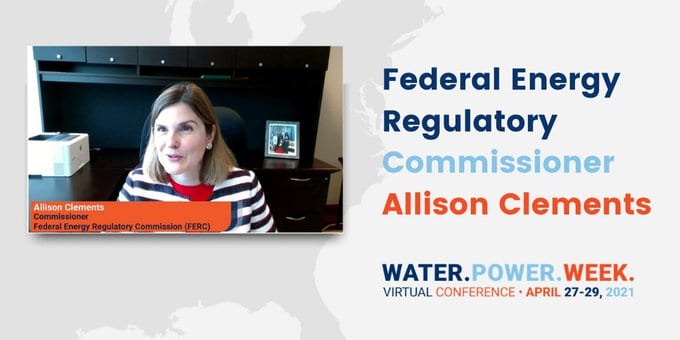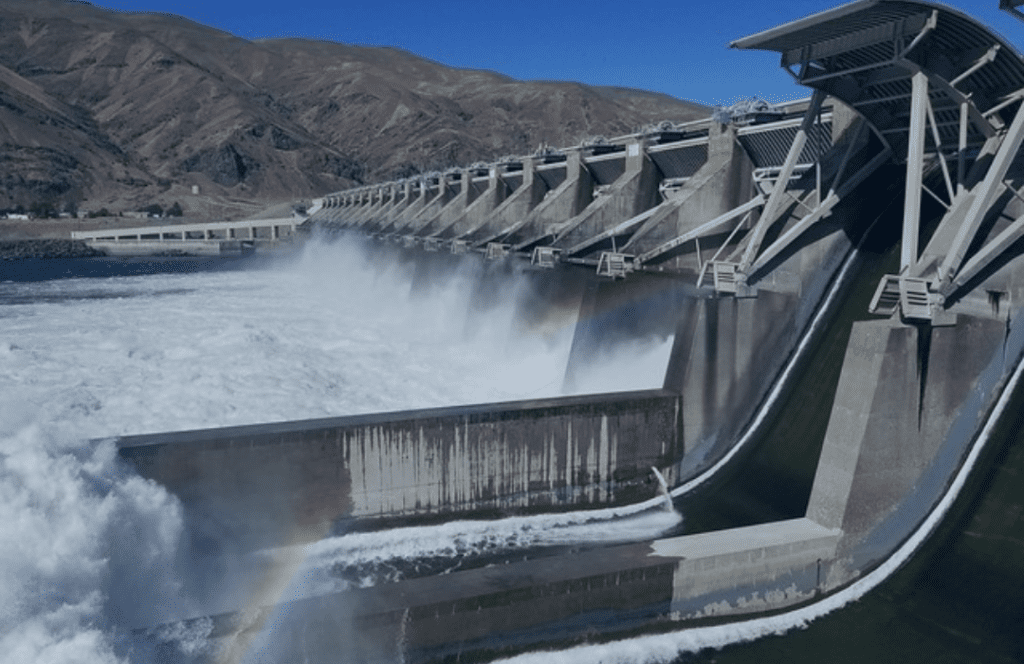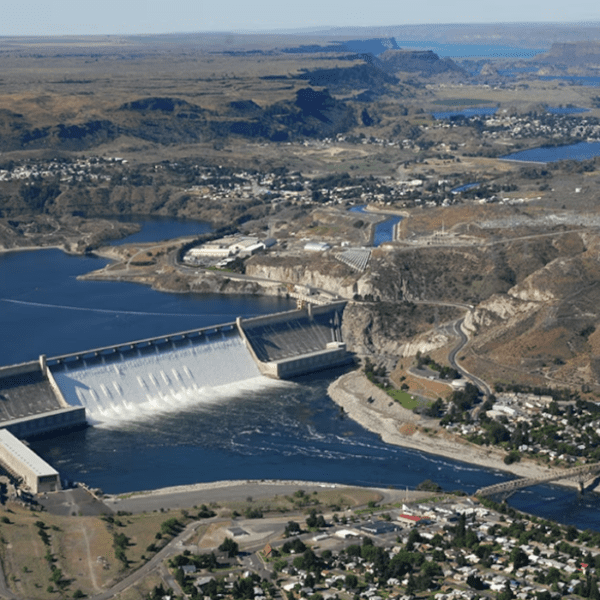Attendees at the April 28, 2021, plenary session during the Waterpower Week conference heard about hydro’s role in the clean energy transition from a Federal Energy Regulatory Commission (FERC) regulator and leaders from the U.S.’s largest grid operators.
In her first address to the hydro industry, FERC Commissioner Allison Clements laid out her priorities and how she believed hydropower could help in a reliable transition.
Following Commissioner Clements, executives from the California Independent System Operation Corporation-CAISO, PJM Interconnection, L.L.C, Midcontinent Independent System Operator-MISO, and ISO New England provided insights into how their markets are evolving and ways those changes may better value the grid attributes of hydro and pumped storage.
All agree on one point: flexibility has to be valued in the grid of the future.

COMMISSIONER CLEMENTS LAYS OUT HER MARKET PRIORITIES
Commissioner Clements explained that she spends much of her time thinking about how she can ensure the clean energy transition happens reliably and cost effectively. In order to do this, she argued, markets must evolve relative to what the system needs now and what it will need in the future.
She said she was pleased with the hydro’s industry’s Brattle report and highlighted one solution in the paper she was open to: better scarcity pricing in energy and ancillary service markets. Recognizing that markets are experiencing difficulty not just during system peaks, she claimed that better pricing could address those times of system stress that occur outside of system peaks.
In response to a question about valuing flexibility, she said “valuing flexibility is important but I’m not sure yet what market products are needed.” Clements argued that solutions should be developed regionally.
She encouraged the National Hydropower Association (NHA) to engage not just with the RTOs but with FERC staff. Regarding how she makes decisions as a Commissioner, she said those decisions “have to be based on the record…the Commission’s role is not to decide who wins or lose in the market; it’s to ensure that everyone has a chance to play.”
RTO LEADERS: DIFFERENT MARKETS, SAME CHALLENGES
The discussion among the executives from four wholesale electricity market operators highlighted similar challenges they all face. Despite the panelists representing starkly different regions and regulatory structures, the challenges identified were very similar.
Derek Bandera, executive director of federal regulatory affairs at MISO explained that the clean energy transition is being driven by a mix of new technologies, state public policies and customer preferences for zero carbon energy. These trends have encouraged MISO’s leaders to focus on availability (when and how often a resource can generate), visibility (the need for grid operators to see all resources on the system) and flexibility (the ability of resources to respond quickly).
Eric Johnson, director of external affairs at ISO-NE, agreed with Bandera and claimed that their main challenge was how to ensure reliability while enabling their states to meet climate goals. “Essentially, we have to reconcile what the states want versus what the grid operators need,” Johnson said. He went on to explain that the grid operators need on-demand energy, 365 days of the year, and they need flexible resources and energy storage — both of which can be provided by conventional hydropower and pumped storage hydro.
VALUING FLEXIBILITY
Anna McKenna, interim vice president of market policy and performance at CAISO, claimed that flexible ramping products are key to having an efficient market and reliable solutions. CAISO and MISO are the only RTOs that have a formal product for ramping, and McKenna claimed they are looking at product enhancements to better value the flexible ramping product.
Johnson described ISO-NE’s efforts to get better pricing into the wholesale markets rather than having to commit resources out of market, something that happens often with pumped storage. Johnson said “solar is displacing other grid resources, but its giving us a very steep ramp in the afternoon and operators are needing to commit fast-responding resources for a long ramp – and that is where flexible resources are key.”
Craig Glazer, vice president of federal government policy at PJM, reminded the audience that not all hydro resources are flexible, so it’s difficult to “paint hydro with a broad brush.” He argued that hydro is in a difficult spot, given that it is mostly a price taker in the market and that it sometimes has unique constraints that impacts its ability to generate at opportune times. Still, he said, hydro will benefit from some of PJM’s reforms around ancillary service pricing, which will increase the value of that service.
CORRECTLY COUNTING ALL RESOURCES’ CAPACITY VALUE
The panelists gave examples of ongoing initiatives at their respective RTOs for how to reform resource adequacy accreditation. In other words, how to do you count any one generator’s contribution toward reliability?
Glazer described PJM’s filing before FERC regarding a new Effective Load Carrying Capability (ELCC) approach for variable and energy-limited resources. ELCC tries to capture the “saturation effect” of renewables. Glazer explained “when you’re adding more and more of an intermittent resource, like a wind or solar resource, there comes a point when the system is saturated, and it doesn’t provide any significant additional reliability value because it’s great when the sun is there, but when the sun goes down all of it may not be there when you need it”.
Bandera said MISO was also reforming the way it approaches resource adequacy, including moving toward a seasonal product that may better value resources in different times of the year.
McKenna argued that “if you count the capacity correctly, either through an ELCC method, or others, then you have less concern about the resources not being there to provide the capacity that’s been procured.” She explained that it was for this reason that CAISO exempted run of river from certain penalties because their value was assessed up front.
“HALF OF LIFE IS JUST SHOWING UP”
All panelists agreed that the hydro industry needs to show up to be heard. When explaining the importance for the hydro industry to get involved in RTO stakeholder proceedings, Glazer used a famous quote: “Half of life is just showing up.”
Acknowledging that the RTO stakeholder process is daunting, he argued that now with many of the meetings being virtual that its perhaps easier than its ever been to get involved.
McKenna likewise suggested that the pumped-storage resources industry get involved in CAISO’s efforts to ensure that storage resources are modeled and dispatched effectively.
NHA’S TAKEAWAYS
From the discussions, it’s clear to NHA that the industry needs to ensure that RTOs are correctly valuing all resources (especially conventional hydro and pumped storage) for their resource adequacy value. This is because if wind and solar are overvalued, then more dependable resources like hydro and pumped storage receive less money in capacity markets (or other RA constructs).
It’s also clear that RTO leaders and Commissioner Allison Clements agree that flexibility has to be valued in the grid of the future. But how to do that is complicated, and it will involve the hydro industry (and other flexible technologies) getting more involved at RTOs and at FERC.











